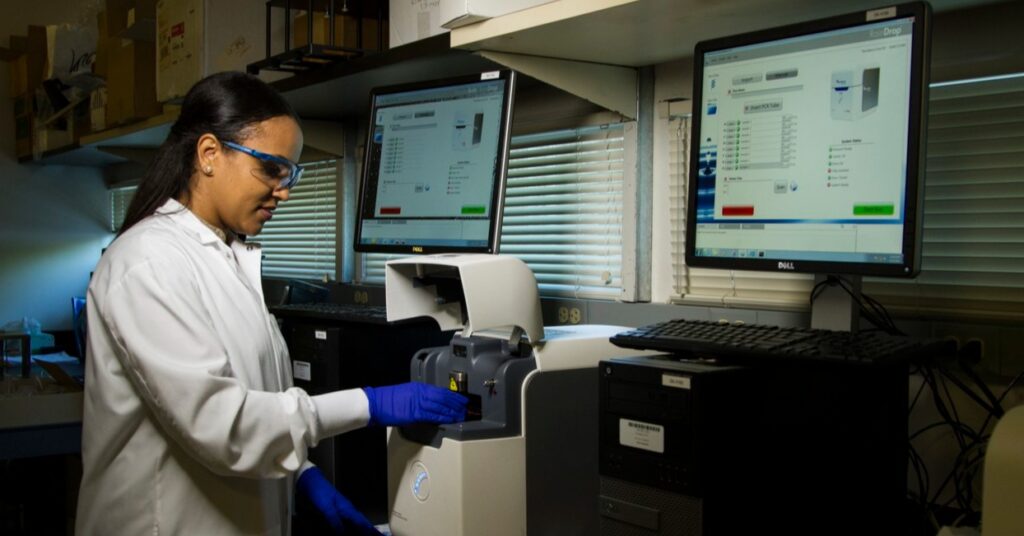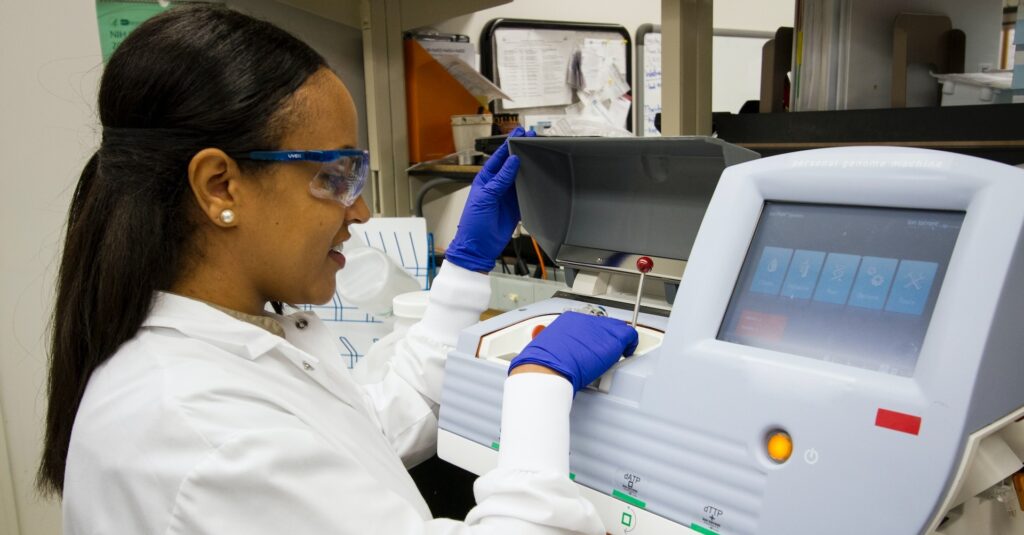
What Is the Epidemiological Triangle?
The epidemiological triad or triangle is an organized methodology used [...]

Optometry offer practitioners a variety of subspecialty options, including ocular disease, vision rehabilitation, geriatric, and pediatric focus areas. Lesser-known specialities are also available; take forensic optometry, for example. For those interested in working alongside law enforcement and crime scene investigators, the little-heralded field of forensic optometry offers the chance to employ science to solve crimes and vindicate the innocent.
Forensic optometry is a rare specialty that blends optometric education with forensic science. Dr. Graham Strong, OD, former clinic director at the University of Waterloo School of Optometry and Vision Science in Ontario, Canada, explains in Optometric Management how a pair of eyeglasses helped him pinpoint a murder suspect at a crime scene otherwise lacking physical evidence. By analyzing the eyeglasses from the suspected murderer’s mug shot and a pair of lenses discovered at the crime scene, Dr. Strong used trigonometry, measurements, and careful cross-examination to confirm the glasses matched.
They probably will never make an action-packed movie about a heroic forensic optometrist, but that doesn’t mean the profession is without its thrills and rewards. This article addresses the question why become a forensic optometrist while discussing:
Forensic optometry combines the skills of optometry and ophthalmology with forensic science and forensic pathology to aid police departments with criminal investigations. Forensic science disciplines include forensic chemistry, trace evidence examination, forensic toxicology, and other specialized areas that examine and analyze evidence from crime scenes. In addition, forensic pathology examines deceased individuals to help determine the cause of death.
What role do optometrists play? The many parts that make up the eye can allow optometrists and ophthalmologists to estimate the time of death by examining the dilatation of the iris and pupil. They can also help identify eyewear left behind at a crime scene that may link to a murder suspect or use biometric technology to identify missing children.
Most optometrists’ practice settings include private practice, optical retail chains, or medical buildings. It’s not that common, but some optometrists also work at crime scenes assisting forensic examiners.
Many forensic optometry duties function on an as-needed basis when crime scenes or forensic investigations warrant the need for an optometrist or ophthalmologist to assist with forensic examination. For instance, a case involving the murder of Janet Abaroa in 2005 led to the “first published documentation of a contact lens from an exhumed body used in a murder investigation.” The contact lens provided critical evidence implicating the victim’s husband as the murderer.
Another optometry function that aids forensic investigations involves using tears and eyewear for DNA profiling. According to a paper published on pubmed.gov, tears found on surfaces such as bedding, tissue, or cloth, can help lead to personal identification. For instance, optometrists can help examine molecular aspects and the biochemistry of tear secretions for DNA analysis. In addition, eyewear or contact lenses left at the scene of a crime may warrant the need for an optometrist’s assistance with forensic investigation.
Whether you’re a fan of true-crime podcasts or want to expand your optometry skills into an unconventional specialization, the reasons vary for becoming a forensic optometrist. For example, when he’s not clocking 45 hours per week at his private practice, Dr. Max Venard, OD, works as a private investigator for about 15 additional hours per week. Venard uses biometric technology to help identify missing children and adults. He also volunteers his time by entering iris scans of Oklahoma children into a national database that helps identify missing children.
Iris identification, a biometric authentication method, uses patterns and image recognition technologies to differentiate the unique characteristics of an individual’s eye.
From non-profit organizations such as the National Center for Missing & Exploited Children (NCMEC) to federal entities like the Federal Bureau of Investigation (FBI) or the United States Department of Justice, more industries are embedding the work of optometrists to impact the greater good.
Forensic optometrists follow the same credentialing process as general optometry practitioners. All optometrists must have a Doctor of Optometry (OD) degree and proper licensure to practice. Additional steps for optometrists specializing in forensics may include obtaining a private investigator license and contacting your local law enforcement to inform them of your services.
Most optometry school doctorate programs follow the traditional four-year format. The New England College of Optometry and the Salus University Pennsylvania College of Optometry offer accelerated OD programs that take three years to complete as well as traditional four-year programs.
Whether you pursue an accelerated program or the typical four-year format, the critical years leading up to your doctorate include:
Overall, earning your Doctor of Optometry degree takes roughly seven to nine years, beginning with the courses taken during undergraduate studies and ending with the required clinical rotations during your final semester of optometry school.
Admission to one of the nation’s 23 accredited optometry schools is competitive. Most optometry programs have similar requirements, including:
Prospective students can submit the above requirements through the Optometry Centralized Application Service (OptomCAS), a convenient portal that allows students to upload one application package to multiple schools.
Additional requirements may include shadowing an optometrist to get a glimpse of an optometry career before committing to optometry school. Also, most programs prefer that prospective students hold a bachelor’s degree in biology, chemistry, physics, or anatomy from an accredited institution.
Optometry programs combine classroom learning with hands-on clinical training throughout the four-year program. The New England College of Optometry (NECO) curriculum provides a roadmap of what you can expect from an optometry program.
The first two years focus on fundamental and advanced competencies to prepare students for their supervised clinical training, which begins during the third year. The third year also allows students to select elective courses to gain specialized knowledge in a focus area of choice. While there aren’t many courses that specialize in forensic optometry, students can expect to learn concepts that could become beneficial if exploring a career in forensics, such as:
Lastly, the program’s final year consists of clinical rotations, combining the skills learned through coursework and clinical training and putting them into practice with actual patients.
All optometrist practitioners must obtain a license to practice, no matter their subspecialty. In addition, these licenses are up for renewal every two years, requiring a commitment to lifelong learning. The National Board of Examiners in Optometry (NBEO) is a three-part comprehensive exam that tests optometry school graduates on basic science concepts, patient diagnosis and treatment, and clinical skills. Additional licensure requirements vary by state.
Optometrists earn six-figure salaries, averaging $124,300 per year. Optometrists who practice as general optometrists by day and forensic optometrists by night have the potential to earn additional income based on the need for their services.
As most accredited optometry programs are within the New England, Midwest, South, and West Coast regions, prospective students from rural areas within the Central part of the country lack access to local optometric education. The New England College of Optometry (NECO) plans to expand education to rural and underserved areas through the first hybrid OD degree program launching in the fall of 2023.
Whether you decide to practice as an optometrist providing patient eye care and treating ocular diseases or desire to team up with forensic scientists examining evidence left behind at crime scenes, ample opportunities exist to utilize your expertise in this versatile field.
(Last Updated on February 26, 2024).
Questions or feedback? Email editor@noodle.com

The epidemiological triad or triangle is an organized methodology used [...]

A family nurse practitioner (FNP) provides comprehensive primary health care [...]

FNPs practice in a broad range of health care settings. [...]

Some epidemiologists assist pharmaceutical companies in developing safer medicines. Some [...]

A Bachelor of Science in Nursing (BSN) is a four-year [...]
Categorized as: Optometry, Nursing & Healthcare